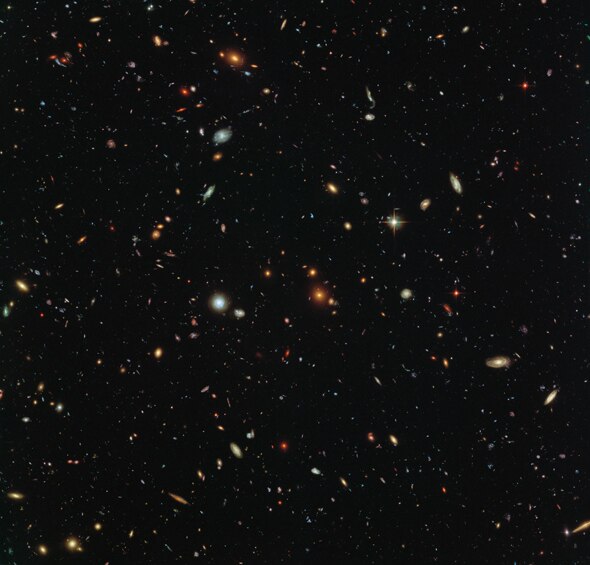Create a free profile to get unlimited access to exclusive videos, sweepstakes, and more!
A Hundred Billion Galaxies

Perhaps you’ve heard that there are a hundred billion galaxies in the Universe. That’s a soul-crushing number, so vast and unreachable that it’s literally hard to believe.
Let me make a believer out of you.
That photo above is from the venerable Hubble Space Telescope. It’s part of a colossal effort by astronomers, dubbed the Frontier Fields program, to peer as deeply as possible into a half-dozen galaxy clusters, veritable cities of galaxies that can contain thousands of galaxies like our own. The combined gravity of these clusters can bend light, which magnifies and amplifies the light coming from even more distant galaxies on the other side of the cluster from us. This “gravitational lensing” allows us to see fainter, more distant galaxies than would be possible without the clusters' aid.
Clusters are where galaxies are more common … but the image above does not show such a cluster. Hubble is a single telescope equipped with several cameras. Each camera sees a slightly different part of the sky when Hubble is pointed at a target. Two main cameras were utilized for Frontier Fields: the Advanced Camera for Surveys (or ACS), and the Wide Field Camera 3 (WFC3).
For this image, the cluster Abell 2744 (also called Pandora’s Cluster) was the main target, and was being observed by WFC3. At the same time, ACS was viewing the nearby part of the sky shown above.
As you can see, it’s filled with galaxies. I scanned the full resolution 6,750 x 6,500 pixel image, and only found a dozen or so objects I could unambiguously identify as stars (point sources like stars get those cross-shaped diffraction spikes through them; extended objects like galaxies smear out the spikes so they become invisible).
In other words, for all intents and purposes, every object you see in that photo is a galaxy, each a sprawling collection of gas, dust, and countless billions of stars, each thousands or even hundreds of thousands of light years across.
I have two points to make here.
First, note how few of the galaxies have what you might think off as overall structure. Sure, many are lens-shaped, spiral, elliptical; but the vast majority are distorted, irregular, peculiar. I would venture that most of these objects you can see are billions of light-years away, so far away that the light we see from them left them when the Universe was far younger. When we look at the nearby Universe, many galaxies do have overall structure, obviously so. But in the distant Universe, things were different.
This right away tells you a fundamental cosmological truth: The Universe changes. It was different when it was younger.
This is a critical piece of evidence that the Universe began. It had a start. It’s one of the many, many pieces of evidence strongly supporting the Big Bang model of the origin of the cosmos. There may have been something out there before it, but what we see now reflects what happened then.
My second point is somewhat more prosaic, though no less profound.
How many galaxies are in this image? Counting them is a daunting task, so I made it simpler on myself: I looked a series of 650 x 675 pixel subsections, and counted the galaxies in each of them. Since the full image is 10 times bigger on each side, the average number of galaxies in each subsection should be 1/100th the total in the image.
I found very roughly 50 identifiable galaxies per subsection. That means the image contains roughly 5,000 galaxies.
The image itself is a tiny, tiny slice of the sky, only a little over three arcminutes on a side. An arcminute is an angular measure of size; there are 60 arcminutes in a degree. The Moon on the sky is about half a degree across, so you can see this is indeed a small piece of cosmic real estate.
There are about 41,000 square degrees in the entire sky, which in turn means there are 41,000 x 60 x 60 = about 150 million square arcminutes in the sky. The image above is about 10 square arcminutes, so it would take 15 million such observations to cover the entire sky.
Perhaps you see where I’m going with this. If there are 5,000 galaxies in the image, and it would take 15 million such fields to cover the sky, then there must be about 5,000 x 15 million = 75 billion galaxies visible in the sky. At least; some will still be too faint to see even in this Hubble image.
Now do you see? Just by taking this observation and applying some high school math, we have discovered that the Universe has something like a hundred billion galaxies in it.
And each of those galaxies has billions of stars. That means there are something like a sextillion stars in the Universe: 1,000,000,000,000,000,000,000 suns.
And it’s reasonable to think that most of those stars have planets, perhaps multiple planets. How many are Earth-like? How many have life?
And yet, in all that—and perhaps more—there’s only one planet just like Earth, only one of all of us. One of you.
Look back at the image taken by Hubble. Look at it closely. The Universe is so vast it may be impossible for us to grasp its size and scale; yet by studying it, by embracing it, we see that our being a part of it is special.
If there is one most amazing thing that astronomy, that science, has shown us, I believe it is that.


























